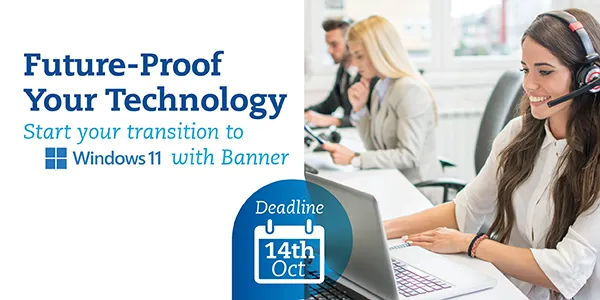Since its release in 2015, Windows 10 has been a staple for countless businesses. However, from the 14th October 2025, Microsoft will officially end support for Windows 10, shifting the focus onto its flagship operating system, Windows 11.
While this may not sound urgent, those organisations reliant on the older operating system could face serious security vulnerabilities, unexpected costs and disruptions.
In this blog, we’ll dive into what the end of support means for your workplace and help you prepare for the transition so your technology remains secure, efficient, and up to date.
What does “end of support” mean?
“End of support” for Windows 10 means that Microsoft will no longer provide security updates, feature updates, or technical assistance for the operating system. Computers running Windows 10 will still function, but will be vulnerable to potential security threats and reduced productivity.
To stay protected, Microsoft strongly advises users to upgrade to Windows 11 before the end of support date to stay secure and continue receiving crucial security updates.
Why does this matter for my workplace?
- Security risks
Cybersecurity is a top priority for workplaces, especially those handling sensitive customer or financial data. Without security updates, Windows 10 will become an easy target for viruses, malware, and hacking attempts. By taking no action, your organisation’s system will be increasingly exposed to cybersecurity threats.
- Operational and compliance challenges
Beyond security risks, an outdated OS can lead to slow performance, software crashes, and IT headaches, further straining office resources and productivity. Many industries also have compliance regulations that require up-to-date security measures, meaning that using an outdated OS could result in non-compliance risks and potential fines.
How to move from Windows 10 to Windows 11
Switching to Windows 11 comes with a host of additional benefits over its predecessor, including:
- 42% faster completion of demanding workloads
- 58% fewer security incidents
- 50% faster average workflows
- 80% fewer helpdesk tickets
So, what steps should you take to integrate the new OS?
- Consult workplace technology specialists
Switching an entire company’s technology set-up can be a daunting task. Therefore, we always recommend consulting a specialist as a first port-of-call. Our team of experts can provide assistance through every step of the journey, from tailored technology recommendations through our partners such as Dell, Lenovo and HP, to implementation and ongoing care.
- Conduct a technology audit
Before making any changes, it is important to understand the scope of the transition. Start by auditing your IT infrastructure to identify all devices still running Windows 10. Microsoft’s PC Health Check is a useful tool to help determine if your systems are compatible with Windows 11. If any devices are incompatible with Windows 11, consider upgrading these devices to prepare for the transition.
It is also worth considering whether all the business applications are Windows 11 compatible. In most instances, it is unlikely there should be a conflict if transitioning from Windows 10 to 11, but be sure to cover all bases to avoid any unexpected issues later down the line.
- Budget and IT support
Once you have audited your business, time should be dedicated to figuring out how much a transition will cost. Thought should also be given to the hardware upgrades required, software licenses and additional IT support. Banner customers can benefit from a consolidated workplace solution, accounting for everything you need to transition your devices over.
Consider these recommended products:
- Intel Core i5 processor
- 8GB memory
- 256GB storage
- Intel Core i5 processor
- 8GB memory
- 256GB storage
- Intel Core i5 processor
- 8GB memory
- 256GB storage
- Prepare your team
If your team is used to Windows 10, switching to Windows 11 should be a seamless transition. However, scheduling training in advance will make the transition smoother and help staff master any new features.
In the run up to the end of support, make sure regular data backups are carried out to avoid any unexpected data losses or errors when transitioning devices over.
Time is of the essence: Get prepared now
With Windows 10 support ending on 14th October 2025, workplaces cannot afford to ignore the upcoming deadline. Security, performance and compliance risks make upgrading a priority for almost every organisation, so assessing your IT setup, budgeting, and planning an upgrade pathway will be essential in the run up to end of support.
Visit our workplace technology page or email to get in touch with our technology experts, ready to guide you through every step of the process.


